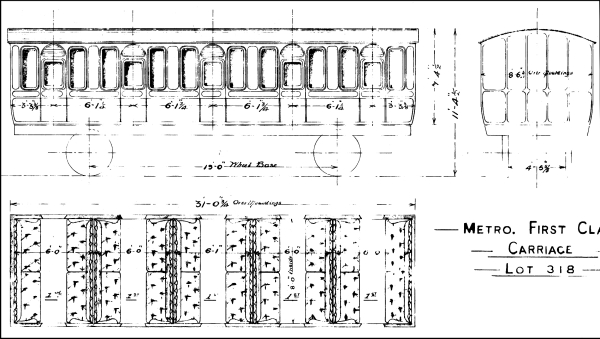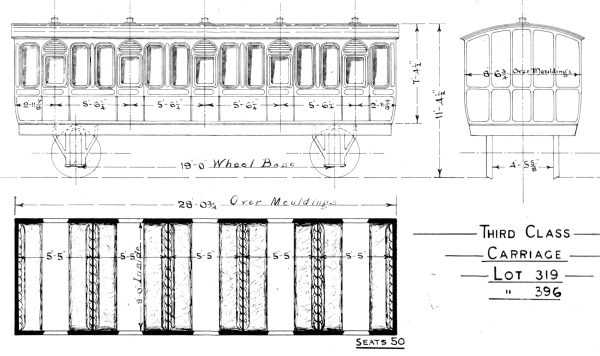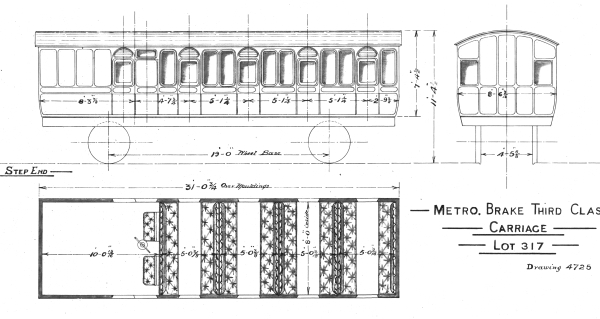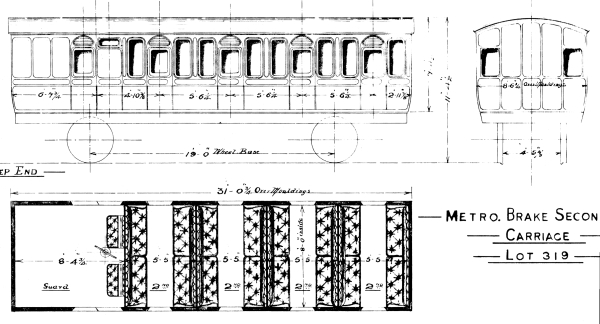|
The London Metropolitan servies comprised of three separate routes:
1. the Main Line & City services which were suburban services from places such as Reading and Windsor to Paddington and the City, these services ran 1863 to 1940 when they were suspended due to the war. 2. the Hammersmith & City services which run from Hammersmith, via Paddington, Bishop's Road to Moorgate, Bishopsgate and Aldgate, it was operated from 1864 to 1906 when it was electrified. 3. the Middle Circle service from the District Railway station at Mansion House to Earl's Court, then via the West London Railway to Kensington (Addison Rd) and then on to Latimer Road on to the Hammersmith & City Railway and then via the Metropolitan Railway to the City of London, it operated from 1872 to 1905. The first coaches specifically built for the London Metropolitan services were like normal coaches of the time, but they had gas lighting fitted from new. In fact they were the first GWR coaches to be so fitted. They were ordered in 1875 and finished in 1876. It's not clear how many trains were formed as the orders were only for 8 first class coaches, 6 second and 4 third class coaches. Clearly it was expected that more well off passengers were going to use the service. Not that they were going to get the comfort that they might have expected. The first class compartments were only 6'9½ wide compared to the normal 7' 0½. Second class compartments were 5' 5 wide vs the normal 6'0½. It was only the third class passengers who got normal size compartments! They were also 5' 5 wide, but had more seats across the coach than second class. These 18 coaches come under the LA9N Lewis style. The first class coaches became diagram R1, the second and third class coaches became S2. There is a record in the registers dated July 1882 for third class coach 215 "One 3rd class comp[artmen]t made into Guards & Lugg[age] at S[windo]n". This is the first record of the possiblity of any brake third or brake second metropolitan coach. In 1886 2 second class coaches were converted to brake seconds and one third converted to a brake third. It's probably that windows were made in the ends at the same time. When diagrams were assigned these brake coaches became diagram T13. Thus it is probable that there were 2 trains were formed: | |||||
| T13 (2nd), S2 (2nd) x 2, R1 x 4, S2 (3rd), T13 (3rd) | |||||
|
It wasn't until 1884 that further coaches for the Metropolitan services were ordered. This time it was an eight coach train formed with a brake second, 2 second class coaches, 2 first class coaches, 2 third class coaches and a brake third. This set was said to have been designed by Holden, who was Dean's assistant. They featured doors with semi-circular tops which are said to have been designed so that they would not hit the tunnel if a door was opened in the tunnel. The body width was 8' 6¾", 6" wider than all but 4 GWR coaches of the time. The roof was the standard single arc adapted for the wider body. The compartment windows were unique in that they reached up to the gutter and there was no wooden eaves panel between the window and gutter. The ends were also unique as they only had 5 panels compared to 6 on all other Dean 8'6 wide coaches. With the exception of the two second class coaches they were all 31' 0¾ long. This style of design is given Lewis style LA0MW. To reduce the train length the coaches were couple close with each other into a set formation. This meant that the bufferbeams were only 1' 10 apart. This was achieved by using extra short buffers on one coach only; the other coach had a thick oak block for the buffers to rub against as can be seen in the adjacent photo. The normal screw coupling was replaced by a special short 3-link coupling. So the coaches in the middle of the set had short buffers on one end and rubbing blocks on the other. The end coaches had normal buffers for the loco to couple to and either short buffers or rubbing blocks on their inner ends. When diagrams were assigned to these coaches the first class coaches had been converted to composites and so became U18, the second class coaches were S20 and T62 for the brake second, the third class coaches were S21 and T61 for the brake third. | |||||
| 1 train formed: | T62, S20 x2, First x2, S21 x2, T61 | ||||
|
This formation is almost the same as the next two Middle Circle trains that were ordered in 1887; the later sets had an additional third class coach.
It is probable that this set stayed more or less complete and together until 1899. In that year half of the set recieved steam heating, two of the seconds were downgraded to thirds and one of the firsts became a brake composite. I suspect that the set was transferred away from London to an area that didn't require second class. | |||||
| Dimensions | |||||
| R1, S2, T13 | LA0MW | ||||
| Width over cornices | 8' 6¼ | 9' 0¼ | |||
| Width over body at waist | 8' 0¾ | 8' 6¾ | |||
| Width over handles | 8' 6⅛ | 9' 0⅛ | |||
| Height to gutters | 10' 1 | 9' 11¾ | |||
| Height to top of roof | 11' 4 | 11' 4½ | |||
| Height over gas lights | 12' 2¾ - Original 12' - Gas Incandecent | 12' 3¼ - Original 12' 0½ - Gas Incandecent | |||
| Diagram | Dimensions Length x Width Wheelbase |
No. Built | Numbers | Conversions | Scrapping Dates | |
no diagram number 5 compartment first 6 wheels | 31' x 8'6 19' |
2 built in 1884 | 126, 131 | 
|
Both to composites U18 in 1899 & 1893 respectively. | None |
5 compartment second/third 4 wheels | 28' x 8'6" 19' |
2 built in 1884 | Second class numbers: 166, 167
The bottom drawing suggests that coaches 210, 235, 445, 520, 710, 755 of lot 396 were built as S20 rather than S18. However, the dimensions in the lot book and coaches registers are consistent with them being S18. |


|
None | 484 - 1922 2465 - 1932 |
6 compartment third 4 wheels | 31' x 8'6" 19' |
2 built in 1884 | 1204, 1205 | 
|
1205 converted to composite no.138 in 1898 with 2x second class and 4x third class compartments it was converted back to third no.2710 in 1907 | 1204 - 1929 2710 - 1930 |
4 compartment brake third | 31' x 8'6" 19' | 1 built in 1884 | 507 | 
| 507 - 1932 | |
4 compartment brake second later converted to third | 31' x 8'6" 19' |
1 built in 1884 | Second class number: 169
Third class number: reclassified and renumbered 1899 |

| 479 - 1936 | |
4 compartment composite with luggage compartment 4 wheels |
31' x 8'6 19' | 2 converted from Firsts in 1893 and 1899 | 144, 175 | 144 was initially converted to 3x 1st class & 2x 2nd class compartments in 1893 then later before finally
175 was converted straight to 2x 1st class & 2x 3rd class compartments and a combined guard and luggage compartment in 1899 |
None | 6175 - 1930 6144 - 1932 |
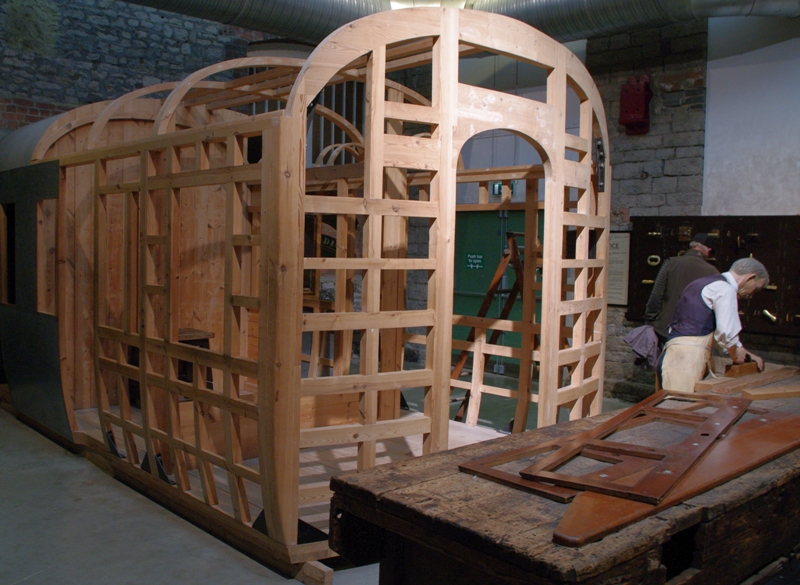
 Clearly in these early years the GWR was using other coaches on these routes. Some would have been purchased prior to the GWR setting up their own carriage workshops. Others must have been pulled in from the general
stock. Unfortunately the surviving records do not show which coaches were used. However records do imply that certain coaches had been adapted for the Metropolitan services.
Clearly in these early years the GWR was using other coaches on these routes. Some would have been purchased prior to the GWR setting up their own carriage workshops. Others must have been pulled in from the general
stock. Unfortunately the surviving records do not show which coaches were used. However records do imply that certain coaches had been adapted for the Metropolitan services.
